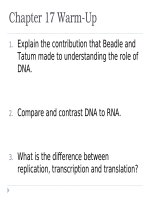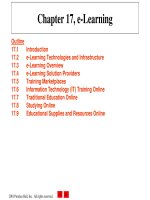Lecture biology (6e) chapter 17 campbell, reece
Bạn đang xem bản rút gọn của tài liệu. Xem và tải ngay bản đầy đủ của tài liệu tại đây (1.59 MB, 86 trang )
CHAPTER 17
FROM GENE TO PROTEIN
Section A: The Connection Between Genes
and Proteins
1. The study of metabolic defects provided evidence that genes specify
proteins
2. Transcription and translation are the two main processing linking gene to
protein: an overview
3. In the genetic code, nucleotide triplets specify amino acids
4. The genetic code must have evolved very early in the history of life
Copyright © 2002 Pearson Education, Inc., publishing as Benjamin Cummings
Introduction
ã TheinformationcontentofDNAisintheformof
specificsequencesofnucleotidesalongtheDNA
strands.
ã TheDNAinheritedbyanorganismleadstospecific
traitsbydictatingthesynthesisofproteins.
ã Proteinsarethelinksbetweengenotypeand
phenotype.
ã Forexample,Mendelsdwarfpeaplantslacka
functioningcopyofthegenethatspecifiesthesynthesisof
akeyprotein,gibberellins.
ã Gibberellinsstimulatethenormalelongationofstems.
Copyrightâ2002PearsonEducation,Inc.,publishingasBenjaminCummings
1.Thestudyofmetabolicdefectsprovided
evidencethatgenesspecifyproteins
ã In1909,ArchibaldGerrodwasthefirsttosuggest
thatgenesdictatephenotypethroughenzymesthat
catalyzespecificchemicalreactionsinthecell.
ã Thesymptomsofaninheriteddiseasereflecta
personsinabilitytosynthesizeaparticularenzyme.
ã Gerrodspeculatedthatalkaptonuria,ahereditary
disease,wascausedbytheabsenceofanenzyme
thatbreaksdownaspecificsubstrate,alkapton.
ã Researchconductedseveraldecadeslatersupported
Gerrodshypothesis.
Copyrightâ2002PearsonEducation,Inc.,publishingasBenjaminCummings
• Progress in linking genes and enzymes rested on
the growing understanding that cells synthesize
and degrade most organic molecules in a series of
steps, a metabolic pathway.
• In the 1930s, George Beadle and Boris Ephrussi
speculated that each mutation affecting eye color
in Drosophila blocks pigment synthesis at a
specific step by preventing production of the
enzyme that catalyzes that step.
• However, neither the chemical reactions nor the
enzymes were known at the time.
Copyright © 2002 Pearson Education, Inc., publishing as Benjamin Cummings
• Beadle and Edward Tatum were finally able to
establish the link between genes and enzymes in
their exploration of the metabolism of a bread
mold, Neurospora crassa.
• They mutated Neurospora with Xrays and screened the
survivors for mutants that differed in their nutritional
needs.
• Wildtype Neurospora can grow on a minimal medium
of agar, inorganic salts, glucose, and the vitamin biotin.
• Most nutritional mutants can survive on a complete
growth medium which includes all 20 amino acids.
Copyright © 2002 Pearson Education, Inc., publishing as Benjamin Cummings
• One type of mutant required only the addition of arginine to
the minimal growth medium.
• Beadle and Tatum concluded that this mutant was defective
somewhere in the biochemical pathway that normally synthesizes
arginine.
• They identified three classes of argininedeficient mutants,
each apparently lacking a key enzyme at a different step in
the synthesis of arginine.
• They demonstrated this by growing these mutant strains in media
that provided different intermediate molecules.
• Their results provided strong evidence for the one
gene one enzyme hypothesis.
Copyright © 2002 Pearson Education, Inc., publishing as Benjamin Cummings
Fig. 17.1
Copyright © 2002 Pearson Education, Inc., publishing as Benjamin Cummings
• Later research refined the one gene one enzyme
hypothesis.
• First, it became clear that not all proteins are
enzymes and yet their synthesis depends on
specific genes.
• This tweaked the hypothesis to one gene one protein.
• Later research demonstrated that many proteins are
composed of several polypeptides, each of which
has its own gene.
• Therefore, Beadle and Tatum’s idea has been
restated as the one gene one polypeptide
hypothesis.
Copyright © 2002 Pearson Education, Inc., publishing as Benjamin Cummings
2.Transcriptionandtranslationarethetwo
mainprocesseslinkinggenetoprotein:an
overview
ã Genesprovidetheinstructionsformakingspecific
proteins.
ã ThebridgebetweenDNAandproteinsynthesisis
RNA.
ã RNAischemicallysimilartoDNA,exceptthatit
containsriboseasitssugarandsubstitutesthe
nitrogenousbaseuracilforthymine.
ã AnRNAmoleculesalmostalwaysconsistsofasingle
strand.
Copyrightâ2002PearsonEducation,Inc.,publishingasBenjaminCummings
• In DNA or RNA, the four nucleotide monomers
act like the letters of the alphabet to communicate
information.
• The specific sequence of hundreds or thousands of
nucleotides in each gene carries the information for
the primary structure of a protein, the linear order
of the 20 possible amino acids.
• To get from DNA, written in one chemical
language, to protein, written in another, requires
two major stages, transcription and translation.
Copyright © 2002 Pearson Education, Inc., publishing as Benjamin Cummings
• During transcription, a DNA strand provides a
template for the synthesis of a complementary
RNA strand.
• This process is used to synthesize any type of RNA
from a DNA template.
• Transcription of a gene produces a messenger
RNA (mRNA) molecule.
• During translation, the information contained in
the order of nucleotides in mRNA is used to
determine the amino acid sequence of a
polypeptide.
• Translation occurs at ribosomes.
Copyright © 2002 Pearson Education, Inc., publishing as Benjamin Cummings
• The basic mechanics of transcription and translation
are similar in eukaryotes and prokaryotes.
• Because bacteria lack nuclei, transcription and
translation are coupled.
• Ribosomes attach to the leading end of a mRNA
molecule while transcription is still in progress.
Fig. 17.2a
Copyright © 2002 Pearson Education, Inc., publishing as Benjamin Cummings
• In a eukaryotic cell, almost all transcription occurs
in the nucleus and translation occurs mainly at
ribosomes in the cytoplasm.
• In addition, before the
primary transcript
can leave the nucleus
it is modified in
various ways during
RNA processing
before the finished
mRNA is exported
to the cytoplasm.
Fig. 17.2b
Copyright © 2002 Pearson Education, Inc., publishing as Benjamin Cummings
• To summarize, genes program protein synthesis via
genetic messenger RNA.
• The molecular chain of command in a cell is :
DNA > RNA > protein.
Copyright © 2002 Pearson Education, Inc., publishing as Benjamin Cummings
3.Inthegeneticcode,nucleotidetriplets
specifyaminoacids
ã Ifthegeneticcodeconsistedofasinglenucleotideor
evenpairsofnucleotidesperaminoacid,there
wouldnotbeenoughcombinations(4and16
respectively)tocodeforall20aminoacids.
ã Tripletsofnucleotidebasesarethesmallestunitsof
uniformlengththatcancodeforalltheaminoacids.
ã Inthetripletcode,threeconsecutivebasesspecify
anaminoacid,creating43(64)possiblecodewords.
ã Thegeneticinstructionsforapolypeptidechainare
writteninDNAasaseriesofthreeưnucleotidewords.
Copyrightâ2002PearsonEducation,Inc.,publishingasBenjaminCummings
• During transcription, one DNA strand, the template
strand, provides a template for ordering the
sequence of nucleotides in an RNA transcript.
• The complementary RNA
molecule is synthesized
according to basepairing
rules, except that uracil is
the complementary base
to adenine.
• During translation, blocks
of three nucleotides,
codons, are decoded into
a sequence of amino acids.
Fig. 17.3
Copyright © 2002 Pearson Education, Inc., publishing as Benjamin Cummings
• During translation, the codons are read in the 5’>3’
direction along the mRNA.
• Each codon specifies which one of the 20 amino
acids will be incorporated at the corresponding
position along a polypeptide.
• Because codons are base triplets, the number of
nucleotides making up a genetic message must be
three times the number of amino acids making up
the protein product.
• It would take at least 300 nucleotides to code for a
polypeptide that is 100 amino acids long.
Copyright © 2002 Pearson Education, Inc., publishing as Benjamin Cummings
• The task of matching each codon to its amino acid
counterpart began in the early 1960s.
• Marshall Nirenberg determined the first match, that
UUU coded for the amino acid phenylalanine.
• He created an artificial mRNA molecule entirely of uracil
and added it to a test tube mixture of amino acids,
ribosomes, and other components for protein synthesis.
• This “poly(U)” translated into a polypeptide containing a
single amino acid, phenyalanine, in a long chain.
• Other more elaborate techniques were required to
decode mixed triplets such a AUA and CGA.
Copyright © 2002 Pearson Education, Inc., publishing as Benjamin Cummings
• By the mid1960s the entire code was deciphered.
• 61 of 64 triplets code
for amino acids.
• The codon AUG not
only codes for the
amino acid methionine
but also indicates the
start of translation.
• Three codons do
not indicate amino
acids but signal
the termination
of translation.
Fig. 17.4
Copyright © 2002 Pearson Education, Inc., publishing as Benjamin Cummings
• The genetic code is redundant but not ambiguous.
• There are typically several different codons that would
indicate a specific amino acid.
• However, any one codon indicates only one amino acid.
• [If you have a specific codon, you can be sure of the
corresponding amino acid, but if you know only the
amino acid, there may be several possible codons.]
• Both GAA and GAG specify glutamate, but no other
amino acid.
• Codons synonymous for the same amino acid often differ
only in the third codon position.
Copyright © 2002 Pearson Education, Inc., publishing as Benjamin Cummings
• To extract the message from the genetic code
requires specifying the correct starting point.
• This establishes the reading frame and subsequent
codons are read in groups of three nucleotides.
• The cell’s proteinsynthesizing machinery reads the
message as a series of nonoverlapping threeletter words.
• In summary, genetic information is encoded as a
sequence of nonoverlapping base triplets, or codons,
each of which is translated into a specific amino acid
during protein synthesis.
Copyright © 2002 Pearson Education, Inc., publishing as Benjamin Cummings
4.Thegeneticcodemusthaveevolvedvery
earlyinthehistoryoflife
ã Thegeneticcodeisnearlyuniversal,sharedby
organismsfromthesimplestbacteriatothemost
complexplantsandanimals.
ã Inlaboratoryexperiments,
genescanbetranscribedand
translatedaftertheyare
transplantedfromonespecies
toanother.
ã Thistobaccoplantisexpressing
atranspiredfireflygene.
Fig.17.5
Copyrightâ2002PearsonEducation,Inc.,publishingasBenjaminCummings
• This has permitted bacteria to be programmed to
synthesize certain human proteins after insertion of
the appropriate human genes.
• This and other similar applications are exciting
developments in biotechnology.
• Exceptions to the universality of the genetic code
exist in translation systems where a few codons
differ from standard ones.
• These occur in certain singlecelled eukaryotes like
Paramecium.
• Other examples include translation in certain
mitochondria and chloroplasts.
Copyright © 2002 Pearson Education, Inc., publishing as Benjamin Cummings
• The near universality of the genetic code must have
been operating very early in the history of life.
• A shared genetic vocabulary is a reminder of the
kinship that bonds all life on Earth.
Copyright © 2002 Pearson Education, Inc., publishing as Benjamin Cummings
CHAPTER 17
FROM GENE TO PROTEIN
Section B: The Synthesis and Processing of RNA
1. Transcription is the DNAdirected synthesis of RNA: a closer look
2. Eukaryotic cells modify RNA after transcription
Copyright © 2002 Pearson Education, Inc., publishing as Benjamin Cummings









